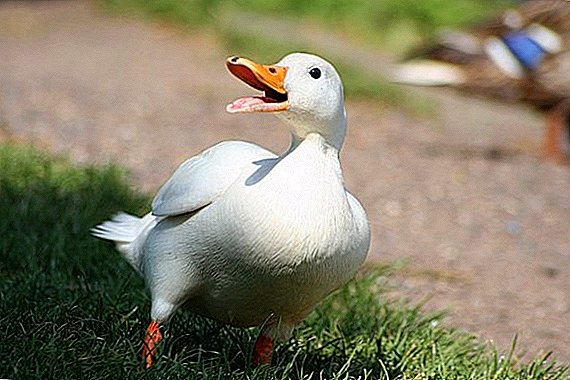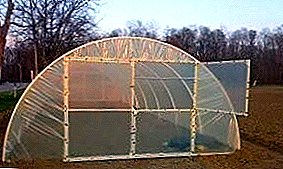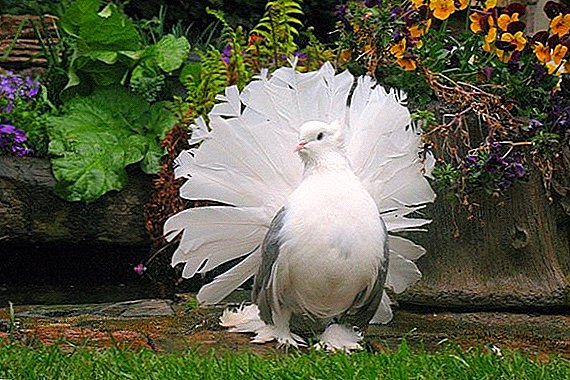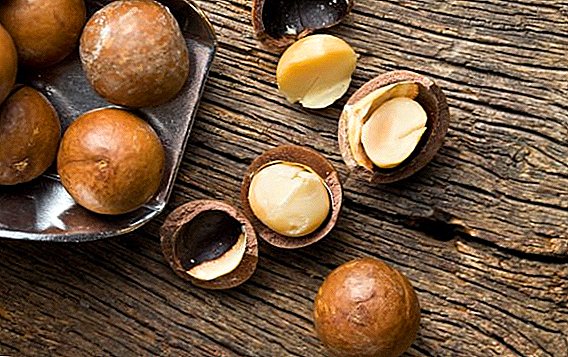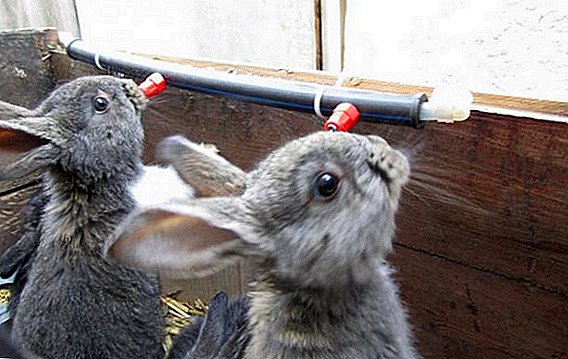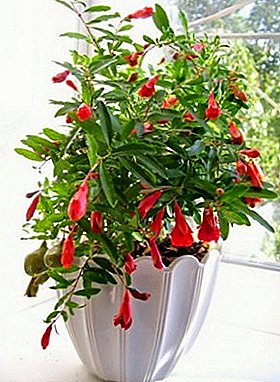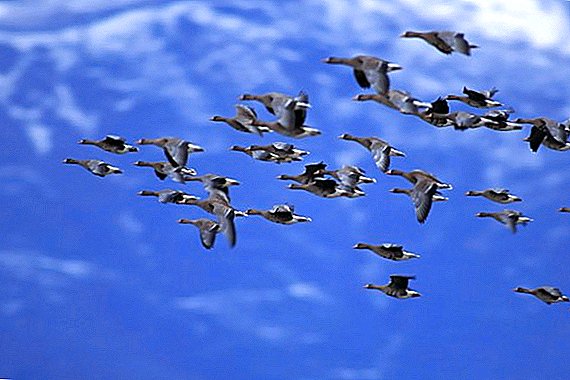 Among the many species of birds, wild geese are of great interest to hunters and ornithologists. They are the same as their domesticated brethren, belong to the family of ducks, but somewhat different in appearance. In total, there are more than 10 species of wild geese. Separately, ornithologists distinguish the geese, which outwardly, though similar to a goose, but has a smaller size and does not publish a typical gaggle of guesses. Further in the article we will consider in more detail the existing species of wild geese with their detailed description.
Among the many species of birds, wild geese are of great interest to hunters and ornithologists. They are the same as their domesticated brethren, belong to the family of ducks, but somewhat different in appearance. In total, there are more than 10 species of wild geese. Separately, ornithologists distinguish the geese, which outwardly, though similar to a goose, but has a smaller size and does not publish a typical gaggle of guesses. Further in the article we will consider in more detail the existing species of wild geese with their detailed description.
Gray
Gray Geese considered to be the ancestors of domestic geese, it was their ancestors who were first domesticated more than 1,300 years BC. er They are the largest and strongest representatives of wild geese.  Individuals of this species are distinguished by light gray plumage, a strong sinewy neck, and a large beak of pink or light flesh color. Body weight varies from 2.5 to 6 kg, the length of the carcass is 75-90 cm, and the wingspan is up to 180 cm. Females and males do not have differences in the color of their plumage; they differ only in size.
Individuals of this species are distinguished by light gray plumage, a strong sinewy neck, and a large beak of pink or light flesh color. Body weight varies from 2.5 to 6 kg, the length of the carcass is 75-90 cm, and the wingspan is up to 180 cm. Females and males do not have differences in the color of their plumage; they differ only in size.
Did you know? A newborn goose will consider the first thing that he sees after birth.Gray geese feed mainly on plant food: grass, acorns, cereals, berries, young tree buds, foliage. For this reason, are considered pests of agricultural land.
They have a specially adapted beak for feeding on plant foods: taller and thinner at the base, and not wide and low planted like in domestic birds.  Gray geese are monogamous - if the birds form a pair, they stay in it for life, the only exceptions are the deaths of one of the partners.
Gray geese are monogamous - if the birds form a pair, they stay in it for life, the only exceptions are the deaths of one of the partners.
In the fall, numerous flocks of gray geese fly away from their nesting sites to the south. They fly in small groups of V-shaped, and then gather in huge colonies on the western and southern coasts of Europe and actively fatten fat, dwelling on the banks of rivers, in the marshland.
Food is mined mainly in the daytime, they can go far to the land in search of food, but in densely populated areas they behave more cautiously and go to feeding at night, and return to rest at dawn.
Due to the intensive development of agriculture, gray geese are deprived of suitable lands, but they are still widespread throughout Central and Eastern Europe and most of Asia. 
Subspecies and breeds of famous birds - pigeons, ducks, quails, partridges, guinea fowls, peacocks, turkeys, decorative and fighting, meat and egg chickens can pleasantly surprise.
White (polar)
Based on the name it becomes clear that the favorite nesting sites white polar geese are the lands of Canada, the eastern part of Siberia and the north of Greenland. Infrequently, they can be found on Wrangel Island, on the territory of Chukotka and in Yakutia. 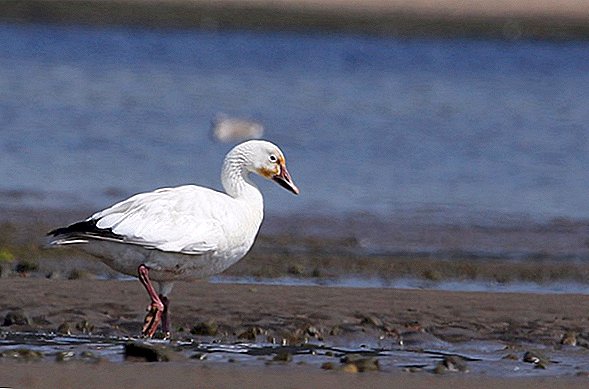 Whether the white goose is a migratory bird or not, we can confidently say: yes - these are migratory birds, migrating to the Gulf of Mexico in winter. Today, this breed is considered almost extinct due to cruel persecution and extermination by humans.
Whether the white goose is a migratory bird or not, we can confidently say: yes - these are migratory birds, migrating to the Gulf of Mexico in winter. Today, this breed is considered almost extinct due to cruel persecution and extermination by humans.
The appearance of this breed is quite spectacular - snow-white plumage of the calf, with black or gray edging of its wings, thick short neck, pink beak and paws. Following the example of many ducks, couples are created for life.
Did you know? In order to protect the eggs from the dangerous fox predator, white goose females prefer to build nests near the polar owl's habitat, which is a natural enemy for the polar fox.These birds are quite friendly and social birds, live in large groups, sometimes up to several thousand individuals. They feed mainly on arctic plant food: mosses, lichens, leaves and shoots, as well as seeds and cereals.

It is interesting to find out how guinea fowls, ducks, peacocks, ostriches, partridges, and pigeons are kept.
Mountain
From the name of the bird it is obvious that this goose lives in the mountainous area - Central and South Asia is considered its birthplace. Breed common in China, Mongolia, Kazakhstan, Kyrgyzstan. In winter, flocks of mountain geese migrate to the lowlands in northern India, as well as to Pakistan, Bangladesh, Bhutan.  English breed name - "bar-headed"that in translation means "with stripes on the head". This type of name was due to the unusual color of the head: on a white background there are two parallel black stripes, one stretches across the back of the head from one eye to the other, and the second is slightly lower, closer to the neck.
English breed name - "bar-headed"that in translation means "with stripes on the head". This type of name was due to the unusual color of the head: on a white background there are two parallel black stripes, one stretches across the back of the head from one eye to the other, and the second is slightly lower, closer to the neck.
The plumage of the calf and wings is light gray, with a black border along the edges of the wings. The beak and paws are painted yellow, and the tip of the beak is marked with a small black speck. The length of adult individuals is 70–80 cm, the wingspan varies from 140 to 160 cm, and its weight varies between 2–3 kg.  Representatives of the breed nest on the shores and islands near the mountain rivers, on the rocks. They walk confidently, because they spend more time on land than in water. The female and male traditionally form a pair for life. Puberty for females comes in 2 years, for males - in 3 years.
Representatives of the breed nest on the shores and islands near the mountain rivers, on the rocks. They walk confidently, because they spend more time on land than in water. The female and male traditionally form a pair for life. Puberty for females comes in 2 years, for males - in 3 years.
The type of feeding of mountain geese is mixed: in their diet there is approximately equally as vegetable food (stalks, leaves, algae), and animal (crustaceans, mollusks, larvae).
This breed is considered one of the highest flying birds. A flight of birds over the Himalayas was recorded at an altitude of more than 10 thousand meters. For comparison: at such a height even a helicopter cannot fly due to rarefied air. 
Important! Because of poaching, the species is on the verge of complete extinction, therefore it is listed in the Red Book of the Russian Federation, and hunting for it is punishable by law.
Chicken
Chicken geese on our territory they are considered exotic birds, since their homeland is the southern part of Australia and the land of Tasmania.
The appearance of the birds is unusual: a light gray plumage, a relatively small head on a short neck, a yellow, humpbacked and highly planted beak, resembling a chicken. Paws of a red shade. The weight of adults can vary from 3 to 6 kg, the length of the carcass is 70-100 cm.  Geese of this breed spend almost all the time on land, because they do not know how to swim, and they fly very hard. From this comes their plant type of food: grass, roots, and grains predominate in the diet, although sometimes birds can eat mollusks, worms, and insects.
Geese of this breed spend almost all the time on land, because they do not know how to swim, and they fly very hard. From this comes their plant type of food: grass, roots, and grains predominate in the diet, although sometimes birds can eat mollusks, worms, and insects.
Birds of this breed can be quite successfully kept at home. When arranging the territory, it is necessary to adhere to the correct ratio of water and land: 20% of the land should be taken under water, and 80% left for pasture.
Birds need enough space in the aviary, so you need to build a room at the rate of 1 square meter. m for one adult. In their standard diet, you can also add chopped vegetables, feed. 
Important! If the density of the enclosure is high, the geese will significantly decrease their productivity, and diseases due to stale air and pollution may also develop.Chicken geese do not know how to giggle and make sounds typical of their breed, their voice rather resembles pork grunt.
Sukhonos
A distinctive feature of the sukhonos are large dimensions: the length of the carcass can reach 100 cm, and the wingspan is from 1.5 to 1.8 meters. The weight of adult birds is 3-5 kg.  Females and males have the same color: the back of the neck, sides and back are painted brown-brown with white transverse stripes, the front of the neck is light, the beak is large, black, with a white stripe at the base. In young individuals, such a strip is absent, for which they can be easily distinguished from sexually mature birds.
Females and males have the same color: the back of the neck, sides and back are painted brown-brown with white transverse stripes, the front of the neck is light, the beak is large, black, with a white stripe at the base. In young individuals, such a strip is absent, for which they can be easily distinguished from sexually mature birds.
Mountains and steppes of Mongolia, China, eastern Siberia, Kazakhstan, Uzbekistan are considered habitual regions of the goose habitat. Birds of this breed inhabit the valleys and meadows near salt and fresh water bodies, prefer terrain overgrown with sedge.
Most of the time spent on land, in case of danger, hiding in the grass. If the danger overtook them on the water - the birds are able to dive deep. The diet is dominated by plant foods: sedge, leaves, berries.  By virtue of the natural gullibility and curiosity of the sukhonos, they began to be domesticated and cultivated in rural areas. Geese of this breed are valued for the good taste of meat. Also practiced is the substrate of the eggs of the wild saponifer to female domestic geese.
By virtue of the natural gullibility and curiosity of the sukhonos, they began to be domesticated and cultivated in rural areas. Geese of this breed are valued for the good taste of meat. Also practiced is the substrate of the eggs of the wild saponifer to female domestic geese.
Nile
The second name of this species of wild geese is Egyptian geese. The birthplace of the breed is the Nile Valley, as well as the territory of Africa south of the Sahara. Three centuries ago, the breed was imported into the countries of Central Europe, but the birds did not respond well to domestication, so numerous populations fled and became wild.  Nile geese have a beautiful appearance: white, gray, red and ocher shades are present in color, eyes are bordered with a brown spot, wings are white with black, paws and a beak are red. These are small birds, their weight can vary from 1 to 4 kg, the wingspan rarely exceeds 1.5 m. There are no color differences between females and males, but the latter are slightly larger.
Nile geese have a beautiful appearance: white, gray, red and ocher shades are present in color, eyes are bordered with a brown spot, wings are white with black, paws and a beak are red. These are small birds, their weight can vary from 1 to 4 kg, the wingspan rarely exceeds 1.5 m. There are no color differences between females and males, but the latter are slightly larger.
The diet of this breed is mixed: vegetable components (grass, seeds, fruits and leaves) and animals (worms, various small animals) are equally present.
Interestingly, representatives of the breed can often show aggression in connection with the assassination of their territory. Birds often keep in pairs or in small groups, jealously protect their places from competitors, sometimes enter into fights, protecting their offspring. Today, in Africa, this breed is considered a pest of fields, as it can easily destroy the whole harvest. Birds are also hunted, because the existence of the species does not cause concern.
Today, in Africa, this breed is considered a pest of fields, as it can easily destroy the whole harvest. Birds are also hunted, because the existence of the species does not cause concern.
Magellan
Magellan goose is also called ash-headed, gray-headed, ashen. Birds of this species nest in the territory of South America: Patagonia, Chile, Argentina, Tierra del Fuego.  According to the type of food, this species belongs to herbivores. The diet of birds consists of leaves, seeds, stems and other parts of plants. They are considered pests on pastures, as they eat crops planted for livestock. Magellan geese prefer to settle on plains and slopes, grassy meadows, near agricultural land.
According to the type of food, this species belongs to herbivores. The diet of birds consists of leaves, seeds, stems and other parts of plants. They are considered pests on pastures, as they eat crops planted for livestock. Magellan geese prefer to settle on plains and slopes, grassy meadows, near agricultural land.
Gray-headed Magellan geese have medium dimensions: the length of the carcass is 60-70 cm, the weight of individuals is 2-3.5 kg.
This is the only species of wild geese, in which females and males have a different color - in males the head and chest are painted white, whereas in females brown color predominates. The color of the paws is also different: in the female they are yellow-orange, and in the male gray-black. The body of both sexes is painted gray.  Representatives of this breed are fairly easy to keep in captivity, as they require a small amount of open water (approximately 25% of the total area). In domestic areas are able to live to 25 years, provided good maintenance.
Representatives of this breed are fairly easy to keep in captivity, as they require a small amount of open water (approximately 25% of the total area). In domestic areas are able to live to 25 years, provided good maintenance.
Beloshey
The second name of this breed is blue goose, which he received due to the characteristic appearance. The bulk of the population is distributed in northern Canada, Alaska, the Pacific coast of the United States and in Siberia.  These are medium-sized birds with a dark body, and the head and back of the neck are white. Weigh an average of 2.5-3.5 kg, males can be as long as 90 cm. On land, it feeds on sedge leaves, berries, herbs, and feeds on water from algae, mollusks, and mussels.
These are medium-sized birds with a dark body, and the head and back of the neck are white. Weigh an average of 2.5-3.5 kg, males can be as long as 90 cm. On land, it feeds on sedge leaves, berries, herbs, and feeds on water from algae, mollusks, and mussels.
In the mating season, birds nest along the coastline, on ponds or islands with good visibility. While the female incubates the eggs, the male remains nearby, guarding the nest from dangerous and uninvited guests. Life expectancy of this breed is rather short in comparison with other species of geese - 6-13 years. 
Humenik
Goose bean gud belongs to the waterfowl species, during nesting it is common in the tundra of Eurasia. In appearance, it resembles a gray goose, however, it differs from it in a darker back and the inner part of the wings, in a two-colored yellow-black beak.  The weight of the carcass varies from 2 to 5 kg and depends on the subspecies of the bird, and the length does not exceed 90 cm. This is usually a migratory species. If we consider where the geese of the bean goose breed winter, we can single out the countries of Western Europe.
The weight of the carcass varies from 2 to 5 kg and depends on the subspecies of the bird, and the length does not exceed 90 cm. This is usually a migratory species. If we consider where the geese of the bean goose breed winter, we can single out the countries of Western Europe.
Traditionally, ornithologists determine four species of bean goose, which are slightly different in their external characteristics (hue of plumage, shape and size of the beak, weight of the carcass):
- Taiga.
- European.
- East Siberian.
- Short-beaked.
The diet is dominated by plant components: herbs, sedge, berries, as well as cereals and vegetables. Humenniki prefer to nest in the forest tundra, tundra, near the marshes, rivers and closed reservoirs. 
Did you know? Gumenniki love to "make some noise" - during feeding, when birds gather in huge flocks, their cackling can be heard for hundreds of kilometers. However, it is unlikely to be seen near the birds, because at the edges of the group there are always watchdogs loudly announcing any danger.
Andean
Homeland of this breed is the highlands of the Andes from Peru to Chile and Argentina, birds live at an altitude of 3000 m and above. Andean goose prefers open areas with short grass, lives in marshland, mountain valleys, river plains, meadows and pastures. Most of the year is carried out at an altitude of more than 3 thousand meters, but sometimes they can descend lower after heavy snowfalls.  Andean geese spend time mostly on the ground, rarely rise into the air, mainly to avoid danger. If it is not possible to take off, they will be saved in the water, however, in the absence of danger, they rarely enter it, because they swim slowly and poorly due to the structure of the body and tail.
Andean geese spend time mostly on the ground, rarely rise into the air, mainly to avoid danger. If it is not possible to take off, they will be saved in the water, however, in the absence of danger, they rarely enter it, because they swim slowly and poorly due to the structure of the body and tail.
The plumage of the head, neck and front of the body is white, the tail and the back are painted black. Beak and paws are marked with a bright red shade. Females and males look almost the same, but females are somewhat inferior in size. The length of individuals is 70-80 cm, the weight can be from 2.7 to 3.6 kg.  There are many species of wild geese, we also considered the features of the main ones. Mostly geese keep on land, although they like to settle near the water, eat plant food, migrate to warm regions in winter, and during the flight or mating games, most of the species emit a typical goose suppression.
There are many species of wild geese, we also considered the features of the main ones. Mostly geese keep on land, although they like to settle near the water, eat plant food, migrate to warm regions in winter, and during the flight or mating games, most of the species emit a typical goose suppression.


